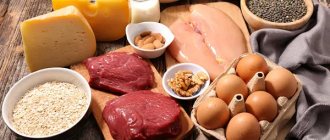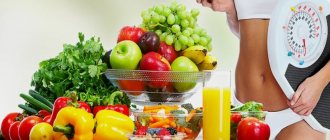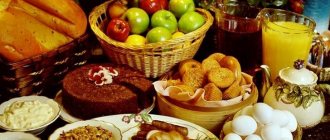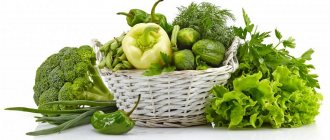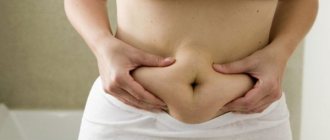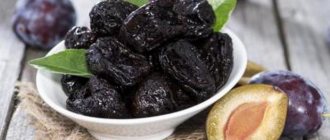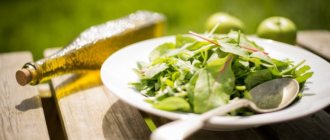according to his level?
The glycemic index (GI) shows how different foods change blood sugar. It compares the body's response to a certain product with its reaction to the consumption of glucose, its GI is 100. Other products have an index from 0 to 100 or more.
GI is not a constant value and depends on:
- Amount and type of carbohydrates;
- The presence or absence of fiber in the product;
- Method of heat treatment;
- Degree of fruit ripening.
There are products with:
- Low GI – no higher than 55;
- Average GI – 56-69;
- High GI – 70 and above.
High GI – in foods, after consumption of which the glucose level rises quickly. Di- and monosaccharides (sucrose, glucose, fructose) are quickly absorbed from the intestine and cause a rapid increase in blood carbohydrates - within 10 minutes after their consumption.
Such products:
- Does not contain fiber;
- They have a small volume;
- Poorly satisfy appetite;
- A short time after taking them, the feeling of hunger returns again, and the person overeats.
Low GI foods are slowly absorbed. They do not raise blood sugar much. Polysaccharides (starch and others) take a long time to break down in the intestines and therefore take longer to be absorbed. After taking them, an increase in glucose occurs after about 30 minutes.
The level of carbohydrates in the blood increases after each meal. However, during normal functioning of the body, their levels should return to normal in two to three hours. Sometimes a slight increase in fasting blood sugar can occur without diabetes, but is caused by pregnancy, inflammation, heart attack, or a large intake of carbohydrate foods the day before. However, any recorded episode of glucose growth must be further examined so as not to miss the onset of diabetes.
Properties of foods with different glycemic index - desktop index table
Table 1. High index foods (easily digestible carbohydrates)
| Product | GI |
| Dried dates | 146 |
| Beer drinks | 110 |
| Shortbread | 106 |
| Boiled beets | 99 |
| Baked potato | 95 |
| Pasta | 90 |
| Mashed potatoes | 90 |
| Honey | 90 |
| Parboiled rice | 83 |
| Muesli with dried fruits and nuts | 80 |
| Potato chips | 80 |
| Sweet corn | 78 |
| Pumpkin | 75 |
| Sweet sparkling water | 70 |
| Boiled potatoes in their jackets | 65 |
| Semolina | 65 |
Products with a GI of 70-100 (mono- and disaccharides) are high-glycemic, they are:
- quickly absorbed and sharply increase blood sugar levels;
- Promote insulin production in a short time;
- Sharply increase energy, a surge of strength;
- Provide the body with carbohydrates for a short time, stimulate appetite;
- Increases the possibility of subcutaneous fat formation.
Table 2. Low index foods whose carbohydrates are complex (“good”)
| Product | GI |
| Apricots (fresh) | 30 |
| Pear | 30 |
| Carrots (raw) | 30 |
| Milk | 30 |
| Yogurt not flavored | 20 |
| Cherry | 20 |
| Eggplant | 20 |
| Mushrooms | 15 |
| Sweet pepper | 15 |
| cucumbers | 15 |
| Radish | 15 |
| Raw white cabbage | 15 |
| Leaf salad | 15 |
| Black currant | 15 |
| Olives | 15 |
| Seafood | 5 |
Products with a GI below 40 (fiber and polysaccharides) are low glycemic:
- Deliver carbohydrates throughout the day, gradually increasing their levels in the blood;
- Slightly increase insulin levels;
- Reduces the load on the pancreas;
- Prevent obesity and diabetes;
- Provides a feeling of fullness;
- Ineffective during physical activity.
When using fruits and vegetables in your diet, you need to take their GI into account. Some of them can also increase sugar.
Fruits and vegetables that are very common in Russia have a high GI:
- Boiled beets – 99;
- Boiled, baked, fried potatoes – 95;
- Boiled carrots – 85;
- Raisins – 65;
- Bananas – 60.
The myth about foods that lower blood sugar
Contrary to the claims of the advertising gods, you cannot eat anything to reduce the level of carbohydrates in the blood. Any food increases sugar levels. A slower rise and lower glucose levels can be achieved by eating low GI foods containing fiber.
The GI of dishes also depends on the composition of the products, methods of preparation and order of intake:
- Products containing starch increase their GI when heated.
- Crushing foods increases their GI, because this way they are digested and absorbed faster.
- The GI will decrease if you add vegetable oil. It slows down digestion and absorption of carbohydrates.
- The absorption of glucose is also affected by the sequence of food intake: it is better to take foods with “slow” sugars at the beginning of a meal (porridge, meat, fish, salads), so that the “fast” carbohydrates (sweets) taken after them are absorbed more slowly. This simple trick significantly slows down the growth of glucose in the blood.
Rules for organizing diabetic nutrition
People with impaired beta cell insulin sensitivity or hormone production should limit their intake of foods that spike their blood sugar levels. It is also recommended to follow the following rules:
- minimize desserts, baked goods and flour products in the diet;
- exclude sugary carbonated drinks;
- refuse high-calorie foods before bed and do not overeat;
- eat less fatty and oil-fried foods;
- serve the meat with a vegetable side dish;
- limit the consumption of alcoholic beverages - alcohol first sharply increases the level of sugar in the blood, and then lowers it to critical values;
- move more and play sports.
The fiber myth
There is an idea that dietary fiber lowers blood glucose. However, fiber is practically not absorbed by the body. The sugar level when taking such products is lower because its absorption slows down. Fiber-rich foods contain vitamins and water, which has no calories. It simply fills the stomach and creates a feeling of fullness. Therefore, the presence of dietary fiber and fiber in the diet prevents the rapid absorption of sugar and keeps it at a low level.
Fiber and plant fibers are found in:
- Greenery;
- Vegetables;
- Berries;
- Some fruits;
- Krupach;
- Products made from wholemeal flour.
Fruits for diabetes
Nutritionists advise eating fresh and frozen fruits. They contain a maximum of minerals, pectin, vitamins and fiber. Together, all these components effectively improve the body’s condition, stimulate intestinal function, remove bad cholesterol and have a positive effect on blood sugar.
On average, a diabetic is recommended to consume 25–30 g of fiber per day. Most of all it contains apples, raspberries, oranges, grapefruits, plums, strawberries and pears. It is advisable to eat apples and pears with the peel on. But tangerines contain a lot of carbohydrates and increase blood sugar. If you have diabetes, you should avoid this type of citrus fruit.
Studies show that watermelon also affects glucose concentration. The berries contain a lot of fructose and sucrose. Moreover, their number increases if the watermelon is stored for too long. For type 2 diabetes, doctors allow you to eat no more than 200–300 g of pulp per day.
Foods that increase blood sugar include tangerines, watermelons, and dried fruits.
Dried fruits also affect sugar levels. It is better not to eat them as a separate dish. Can be used for cooking compote, after soaking in cold water (for 6 hours). Soaking removes excess glucose.
Facts about GI in different foods
- Dairy products are the basis of nutrition for the majority of the population. Their GI is 15-80. Those containing sugar have a higher index.
- Flour products have a GI of 35-100. Its level is affected by food additives: raising agents, sweeteners, flavor enhancers.
- GI of grain products – 20-90. They are low in fat. Carbohydrates in cereals are polysaccharides, which slowly increase blood glucose. GI levels in grain products are also affected by added sugar.
- GI of confectionery products – 20-90. The high index of most of them is also associated with the presence of sugar. They should be consumed after a meal that slows down digestion and preferably before 14:00.
- Vegetables reduce the GI of food, slowing down the absorption of carbohydrates and the speed of digestion.
- Fruits that contain dietary fiber reduce GI.
- Soft drinks have a GI of 15-110. For most, it is high due to sugar, and carbonation further increases the absorption of carbohydrates.
- Products containing fat (oils and sauces) have a GI of 15-60. It is better to use vegetable oils. They have the lowest GI.
- The GI of nuts is 8-30, they contain a lot of fat and are difficult to digest.
Useful advice from nutritionists
How to avoid excessive increase in blood carbohydrates:
- If you have an irresistible need to eat sweets, try sugar substitutes.
- Avoid candy, especially hard candy. Use marshmallows and marmalade.
- Fill your diet with complex carbohydrates. With slow absorption of glucose, the performance of the pancreas increases.
- You need to eat: whole grain cereals (buckwheat, barley, oatmeal, barley, brown rice); bran; foods containing fiber, which slow down the absorption of sugar; a lot of natural vegetables (up to 2/3 of the daily diet).
- When eating fruits, you need to pay attention to their GI. It is better not to overuse dried fruits, bananas, apricots, grapes and eat them not on an empty stomach, but after the main meal.
- Reduce the amount of animal fats you eat; they need to be replaced with vegetable ones.
- Instead of regular cheese, you can sometimes eat tofu, and occasionally replace the usual milk with almond, soy, rice or coconut.
- Choose lean meats - veal, chicken breast, turkey. When cooking poultry, remove the skin.
- The most healthy dishes are steamed, fresh, baked, boiled. During cooking, replace animal fat with vegetable fat.
- Recommended foods : legumes, cabbage.
- Among the berries, blueberries are prized. It can reduce blood glucose, stimulate insulin secretion and normalize the activity of the pancreas.
- Doctors advise using garlic, onions, celery, herbs, vegetable smoothies and fresh juices in your diet.
- Coffee lovers should change their drink to chicory. Instead of black tea, it is better to drink herbal or green tea.
- You need to eat food often (at least 5 times a day) and in small portions. This way you will protect the pancreas from overload.
- Fasting will lower your blood sugar and increase hunger, but will not be beneficial.
- Do not eat at the computer or in front of the TV - you will definitely eat too much while being distracted by watching programs.
- When preparing food, people often eat full portions - don't forget about it.
- If you feel acute hunger, try to control yourself. To begin with, you can eat something light and low-calorie - an apple, lettuce, a slice of pineapple, drink tea with lemon.
- Avoid stress that leads to overeating.
- Spend a lot of time in nature.
- Monitor your blood sugar using a portable glucose meter. Monitor your blood pressure.
What happens if you don't follow the diet?
Failure to follow a diet can cause serious consequences. Among them:
- Diabetic coma is the body's reaction to a sharp increase in glucose. Accompanied by confusion, breathing problems, a strong odor of acetone, and lack of urination. Coma can occur with any type of diabetes.
- Ketoacidosis - provokes the appearance of a large amount of waste in the blood. A characteristic symptom is a disruption of all functions in the body, which leads to loss of consciousness of a person. Usually appears in type 1 diabetes.
- Hypoglycemic coma - occurs due to a sharp decrease in glucose. This phenomenon is provoked by alcohol consumption, non-compliance with the diet, and the systematic use of sweeteners. Occurs in all types of diabetes.
You should not use sweeteners often or in large quantities. They have many side effects that lead to various pathologies. It is safe to use them no more than 1-2 times a week.
Products that increase blood sugar should absolutely not be consumed by people who suspect hyperglycemia. A small amount can provoke a sharp increase in glycemia. A person may lose consciousness and face the development of various pathologies.
How to stop vomiting in a child, read here.

